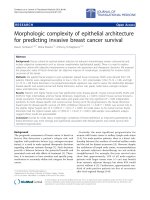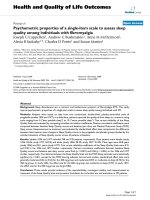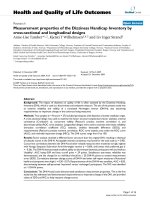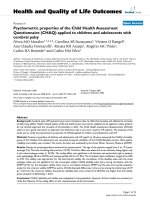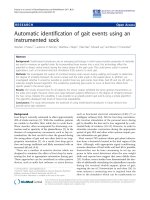Báo cáo hóa học: " Catalytic properties of Co3O4 nanoparticles for rechargeable Li/air battery" doc
Bạn đang xem bản rút gọn của tài liệu. Xem và tải ngay bản đầy đủ của tài liệu tại đây (868.33 KB, 11 trang )
This Provisional PDF corresponds to the article as it appeared upon acceptance. Fully formatted
PDF and full text (HTML) versions will be made available soon.
Catalytic properties of Co3O4 nanoparticles for rechargeable Li/air battery
Nanoscale Research Letters 2012, 7:47 doi:10.1186/1556-276X-7-47
Kwan Su Kim ()
Yong Joon Park ()
ISSN 1556-276X
Article type Nano Express
Submission date 8 September 2011
Acceptance date 5 January 2012
Publication date 5 January 2012
Article URL />This peer-reviewed article was published immediately upon acceptance. It can be downloaded,
printed and distributed freely for any purposes (see copyright notice below).
Articles in Nanoscale Research Letters are listed in PubMed and archived at PubMed Central.
For information about publishing your research in Nanoscale Research Letters go to
/>For information about other SpringerOpen publications go to
Nanoscale Research Letters
© 2012 Kim and Park ; licensee Springer.
This is an open access article distributed under the terms of the Creative Commons Attribution License ( />which permits unrestricted use, distribution, and reproduction in any medium, provided the original work is properly cited.
1
Catalytic properties of Co
3
O
4
nanoparticles for rechargeable Li/air batteries
Kwan Su Kim
1
and Yong Joon Park
*1
1
Department of Advanced Materials Engineering, Kyonggi University, San 94-6, Yiui-
dong, Yeongtong-gu, Suwon, Gyeonggi-do, 443-760, Republic of Korea
*Corresponding author:
Email addresses:
KSK:
YJP:
Abstract
Three types of Co
3
O
4
nanoparticles are synthesized and characterized as a catalyst for
the air electrode of a Li/air battery. The shape and size of the nanoparticles are observed
using scanning electron microscopy and transmission electron microscopy analyses. The
formation of the Co
3
O
4
phase is confirmed by X-ray diffraction. The electrochemical
property of the air electrodes containing Co
3
O
4
nanoparticles is significantly associated
with the shape and size of the nanoparticles. It appears that the capacity of electrodes
containing villiform-type Co
3
O
4
nanoparticles is superior to that of electrodes
containing cube- and flower-type Co
3
O
4
nanoparticles. This is probably due to the
sufficient pore spaces of the villiform-type Co
3
O
4
nanoparticles.
Keywords: composites; nanostructures; chemical synthesis; electrochemical properties.
Introduction
A significant increase in the energy density of rechargeable batteries is required to
satisfy the demands of vehicular applications and energy storage systems. One approach
to solving this problem is the introduction of a new battery system having a higher
energy density. Li/air batteries are potential candidates for advanced energy storage
systems because of their high storage capability [1-3]. They do not store a ‘cathode’ in
the system, which allows for a higher energy density than any other commercial
rechargeable batteries. Instead, oxygen from the environment is reduced by a catalytic
surface inside the air electrode. Thus, catalysts are key materials that affect the capacity,
cycle life, and rate capability of such batteries.
In this study, the Co
3
O
4
nanoparticles of various shapes and structures were tested as
catalysts of air electrodes for rechargeable Li/air batteries. Co
3
O
4
with a spinel structure
has attracted a considerable interest as a potential catalyst in various application fields
[4-7]. In particular, this study was motivated by the notion that the catalytic efficiency
of oxides is highly dependent on their morphology, size, and crystal structure [8, 9].
2
Herein, three types of Co
3
O
4
of various shapes and morphologies were synthesized, and
the electrochemical properties of the air electrodes containing Co
3
O
4
nanoparticles were
characterized.
Experimental details
Three types of Co
3
O
4
nanoparticles were prepared by a hydrothermal reaction using
cobalt nitrate (cube type, flower type) and cobalt chloride (villiform type), considering
previous reports [10, 11]. Surfactants such as urea were also added to obtain nanosized
particles. X-ray diffraction [XRD] patterns of powders were measured using a Rigaku
X-ray diffractometer (Rigaku Corporation, Tokyo, Japan). The microstructure of the
powder was observed by field-emission scanning electron microscopy [FE-SEM]
(JEOL-JSM 6500F, JEOL Ltd., Akishima, Tokyo, Japan) and field-emission
transmission electron microscopy [FE-TEM] (JEOL-JEM 2100F JEOL Ltd., Akishima,
Tokyo, Japan). The electrochemical performance of the air electrode containing Co
3
O
4
nanoparticles was examined using a modified Swagelok cell, consisting of a cathode, a
metallic lithium anode, a glass fiber separator, and an electrolyte of 1 M LiTFSI in
EC/PC (1:1 vol.%). The cathode contained carbon (Ketjen black EC600JD, Akzo Nobel,
Amsterdam, The Netherlands; approximately 1420m
2
·g
−1
), catalysts (Co
3
O
4
nanoparticles), and a binder (PVDF; Sigma-Aldrich, St. Louis, MO, USA ). The molar
ratio of carbon to catalysts was adjusted to 95:5. The binder accounted for 20 wt.% of
the total electrode. The cells were assembled in an Ar-filled glove box and subjected to
galvanostatic cycling using a WonATech (WBCS 3000, Seocho-gu, Seoul, Korea)
charge-discharge system. Experiments were carried out in 1 atm of O
2
using an air
chamber.
Results and discussion
Scanning electron microscopy [SEM] and transmission electron microscopy [TEM]
were employed to investigate the shapes of the samples (Figure 1). Cube-type Co
3
O
4
nanoparticles have a homogeneous cubic morphology (Figure 1a). The length of the
nanocube was around 200 nm, and the dominant exposed plane of the cube-type Co
3
O
4
seemed to be {001}. The villiform-type Co
3
O
4
particles were formed by a nucleus
covered with numerous micrometer-sized nanorods. In comparison with the length, the
diameter of the nanorod was very small (less than 100 nm). It is interesting that the
villiform-type Co
3
O
4
has a rough surface. As shown in the TEM image (Figure 1b), the
nanorods seemed to be stacked with smaller nanoparticles with a diameter of
approximately 80 nm. The flower-type Co
3
O
4
seemed to have a similar shape and size
to those of the villiform-type Co
3
O
4
. However, the nanorods of the flower-type Co
3
O
4
had a sharper end, smoother surface, and smaller diameter than those of the villiform-
type Co
3
O
4
. Moreover, in contrast with the villiform-type Co
3
O
4
, the nanorods of the
flower-type Co
3
O
4
particles were almost separated during the preparation process for
the TEM experiments (Figure 1c). This implies that the flower-type Co
3
O
4
particles may
turn to the nanorod type during the electrode fabrication process because of vigorous
mixing in making a slurry. The crystallinity of the three types of Co
3
O
4
nanoparticles
was investigated by XRD. As shown in Figure 2, all XRD peaks of the cube-type Co
3
O
4
3
nanoparticles can be indexed to the Co
3
O
4
spinel phase, indicating a single-phase
sample. Most diffraction peaks for villiform- and flower-type Co
3
O
4
particles were also
identical to those of the typical Co
3
O
4
phase; however, small impurities could be
detected in the diffraction patterns.
The electrochemical properties of the air electrodes containing Co
3
O
4
nanoparticles
were characterized at a constant current density of 0.4 mA·cm
−2
at 30°C. Figure 3a
shows the initial voltage profile of the electrodes containing the Co
3
O
4
nanoparticles in
the voltage range of 4.35 to 2.3 V. The discharge capacity shown in Figure 3 is based on
the weight of carbon (Ketjen black) in the air electrode, which has generally been used
for expressing the capacity of an air electrode [1, 8, 9, 12]. The average charge and
discharge voltages of the air electrode containing the Co
3
O
4
nanoparticles were
approximately 4.2 and 2.6 V, respectively. The initial discharge capacity of the electrode
was highly dependent upon the type of Co
3
O
4
nanoparticles. The electrode containing
villiform-type Co
3
O
4
nanoparticles showed a relatively higher initial discharge capacity
(approximately 2,900 mA h·g
−1
) than with the other electrodes. In contrast, the initial
discharge capacities of the electrodes containing flower-type Co
3
O
4
nanoparticles were
just about 1,800 mA h·g
−1
although they have a shape very similar to the villiform-type
Co
3
O
4
nanoparticles. As shown in Figure 3b, the cyclic performance of the air
electrodes was not satisfactory. Actually, capacity fading has been a typical feature of all
previous results about air electrodes [8, 12, 13]. It has been known that cycle
degradation is associated with irreversible reaction products, which accumulate in the
pores of the electrode at a discharged state [13, 14]. It seems that the practical
rechargeability of air electrodes has yet to be achieved before these can be put to
practical use.
After 10 cycles, the electrode was discharged to 2.3 V, and the surface was observed by
SEM to investigate the morphology change during cycling. In the SEM images of the
air electrodes before testing, the Co
3
O
4
nanoparticles and carbon (Ketjen black) could
be clearly identified (Figure 4). It was noticeable that the villiform-type Co
3
O
4
nanoparticles maintained their shape during the electrode-fabrication process. However,
the flower-type Co
3
O
4
nanoparticles were almost separated to become the nanorod type.
When they discharged to 2.3 V, it was observed that the surface of the electrode was
homogenously covered with precipitates, which appeared to be reaction products such
as lithium oxides, and lithium carbonates formed due to electrolyte decomposition [15,
16]. These reaction precipitates could block the catalyst/carbon contact area, thereby
preventing O
2
intake and Li
+
delivery to the active reaction site and terminating the
discharge process. According to previous reports [13, 14], there was a strong correlation
between average pore diameter and discharge capacity. Reaction precipitates are likely
to be formed near active sites so that the micropore of a porous electrode would be
easily sealed with precipitates of lithium oxides during discharge. Thus, securing
enough space between catalytic active sites might increase the discharge capacity of the
air electrode. The cube- and flower- (nanorod- in the electrode) type Co
3
O
4
nanoparticles may be well covered with small carbon particles (Ketjen black) in the air
electrode so that a sufficiently small pore space could be obtained. On the other hand,
the villiform-type Co
3
O
4
nanoparticles were composed of a nucleus covered with many
nanorods of approximately 100 nm in size, which could offer enough space between
4
active catalytic sites. Thus, a greater amount of lithium oxide precipitation may be
needed to block the pore orifices and terminate the discharge process; this could be an
explanation for the higher discharge capacity of the air electrode containing villiform-
type Co
3
O
4
nanoparticles in comparison with the air electrode containing other types
Co
3
O
4
nanoparticles.
Conclusions
Cube-, flower-, and villiform-type Co
3
O
4
nanoparticles were synthesized and introduced
as catalysts for Li/air batteries. The electrochemical properties of the air electrodes
containing Co
3
O
4
nanoparticles were found to be highly dependent on the type of Co
3
O
4
nanoparticles. The electrode containing villiform-type Co
3
O
4
nanoparticles showed a
higher discharge capacity than the electrodes containing other types of Co
3
O
4
nanoparticles. This is likely due to the relatively sufficient pore space between active
catalytic sites, which stores a large amount of reaction products.
Abbreviations
EC, ethylene carbonate; FE-SEM, field-emission scanning electron microscopy; FE-
TEM, field-emission transmission electron microscopy; LiTFSI, lithium
bis(trifluoromethanesulfonyl)imide; PC, propylene carbonate; PVDF, polyvinylidene
fluoride; XRD, X-ray diffraction.
Competing interests
The authors declare that they have no competing interests.
Authors' contributions
KS did the synthetic and characteristic works in this journal. YJ gave the advice and
guided the experiment. All authors read and approved the final manuscript.
Acknowledgments
This work was supported by the grant of the National Research Foundation of Korea
funded by the Korean Government (MEST; NRF-2009-C1AAA001-0094219).
5
References
1. Ogasawara T, Débart A, Holzapfel M, Novák P, Bruce PG: Rechargeable Li
2
O
2
electrode for lithium batteries. J Am Chem Soc 2006, 128:1390-1393.
2. Zhang SS, Foster D, Read J: Discharge characteristic of a non-aqueous
electrolyte Li/O
2
battery. J Power Sources 2010, 195:1235-1240.
3. Zhang JG, Wang DY, Xu W, Xiao J, Williford RE: Ambient operation of Li/Air
batteries. J Power Sources 2010, 195:4332-4337.
4. Wang X, Yu L, Wu XL, Yuan F, Guo YG, Ma Y, Yao J: Synthesis of single-
crystalline Co
3
O
4
octahedral cages with tunable surface aperture and their
lithium storage properties. J Phys Chem C 2009, 113:15553-15558.
5. Teng F, Yao W, Zheng Y, Ma Y, Xu T, Gao G, Liang S, Teng Y, Zhu Y: Facile
synthesis of hollow Co
3
O
4
microspheres and its use as a rapid responsive CL
sensor of combustible gases. Talanta 2008, 76:1058-1064.
6. Yang Y, Huang K, Liu R, Wang L, Zeng W, Zhang P: Shape-controlled synthesis of
nanocubic Co
3
O
4
by hydrothermal oxidation method. Trans Nonferrous Met Soc
2007, 17:1082-1086.
7. Zhang Y, Liu Y, Fu S, Guo F, Qian Y: Morphology-controlled synthesis of Co
3
O
4
crystals by soft chemical method. Mater Chem Phys 2007, 104:166-171.
8. Jiao BF, Bruce PG: Mesoporous crystalline β-MnO
2
—a reversible positive
electrode for rechargeable lithium batteries. Adv Matter 2007, 19:657-660.
9. Débart A, Paterson AJ, Bao J, Bruce PG: a-MnO
2
nanowires: a catalyst for the O
2
electrode in rechargeable lithium batteries. Angew Chem 2008, 47:4521-4524.
10. Jiang A, Wu Yue, Xie B, Xie Y, Qian Y: Moderate temperature synthesis of
nanocrystalline Co
3
O
4
via gel hydrothermal oxidation. Mater Chem Phys 2002,
74:234-237.
11. Zhang Y, Liu Y, Fu S, Guo F, Qian Y: Morphology-controlled synthesis of Co
3
O
4
crystals by soft chemical method. Mater Chem Phys 2007, 104:166-171.
12. Débart A, Bao J, Armstrong G, Bruce PG: An O
2
cathode for rechargeable
lithium batteries: the effect of a catalyst. J Power Sources 2007, 174:1177-1182.
6
13. Kraytsberg A, Ein-Eli Y: Review on Li-air batteries-opportunities, limitations
and perspective. J Power Sources 2011, 196:886-893.
14. Tran C, Yang XQ, Qu D: Investigation of the gas-diffusion-electrode used as
lithium/air cathode in non-aqueous electrolyte and the importance of carbon
material porosity. J Power Sources 2010, 195:2057-2063.
15. Xu W, Viswanathan V, Wang D, Towne S, Xiao J, Nie Z, Hu D, Zhang J:
Investigation on the charging process of Li
2
O
2
-based air electrodes in Li–O
2
batteries with organic carbonate electrolytes. J Power Sources 2011, 196:3894-
3899.
16. Freunberger SA, Chen Y, Peng Z, Griffin JM, Hardwick LJ, Bard F, Novak P,
Bruce PG: Reactions in the rechargeable lithium-O
2
battery with alkyl carbonate
electrolytes. J Am Chem Soc 2011, 133:8040-8047.
Figure 1. SEM (left side) and TEM (right side) images of the Co
3
O
4
nanoparticles.
(a) Cube type, (b) villiform type, and (c) flower type.
Figure 2. XRD patterns of the Co
3
O
4
nanoparticles and reference Co
3
O
4
.
Figure 3. Electrochemical properties of the air electrode containing Co
3
O
4
nanoparticles. Air electrode containing Co
3
O
4
nanoparticles at a constant current
density of 0.4 mA·cm
−2
(voltage range of 4.35 to 2.3 V). (a) Initial voltage profile and
(b) cyclic performance.
Figure 4. SEM images of the air electrodes. Air electrodes composed of Co
3
O
4
nanoparticles, carbon (Ketjen black), and binder before the test and after discharge at
2.3 V. (a) Cube type, (b) villiform type, and (c) flower type.
(a)
(b)
(c)
1
2
2
Figure 1
Figure 2
Figure 3
(b)
(a)
(c)
0.5
2
2
1
Catalyst
Ketjen
Black
Catalyst
Catalyst
Ketjen
Black
Ketjen Black
0.5
0.5
Figure 4

